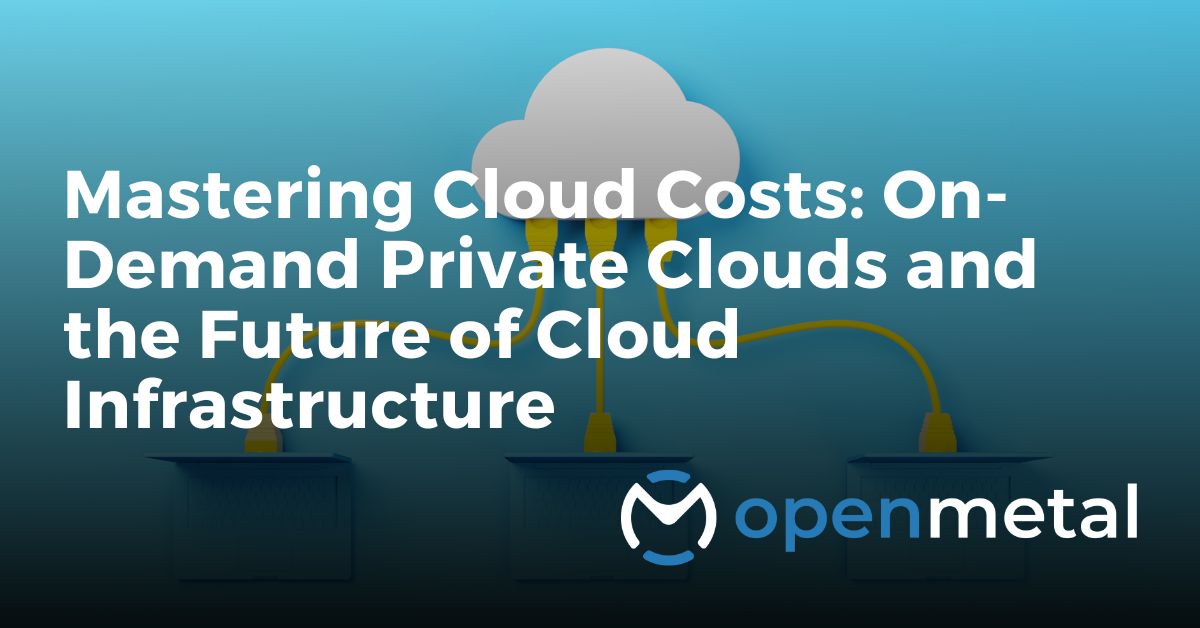
In this blog
- Introduction: On-Demand Private Clouds Revolutionize Cloud Infrastructure by Reducing Costs and Enhancing Flexibility
- The Emergence of On-Demand Private Clouds
- Ease of Use and Impact on Hybrid Clouds and Primary Uses
- Pricing Advantages and Cloud Cost Comparisons
- Key Advantages of Private Cloud Over Public Cloud
- Evolving Market Landscape for Cloud Providers
- Mastering Cloud Costs: Wrapping Up
Introduction: On-Demand Private Clouds Revolutionize Cloud Infrastructure by Reducing Costs and Enhancing Flexibility
With the growing popularity of cloud services, organizations are continuously looking for ways to optimize costs and improve their IT infrastructure. On-demand private clouds have emerged as a viable solution for businesses to reap the benefits of both reduced costs and enhanced flexibility. In this blog post, we’ll explore the evolution and benefits of on-demand private clouds and alternative cloud infrastructure solutions, and how they can maximize ROI for many businesses.
The Emergence of On-Demand Private Clouds
History of on-demand private clouds: Dell’s VMware, HPE’s Greenlake, OpenStack
On-demand private clouds emerged in 2018 from traditional industry names building from their history in on-premise closed source private clouds. Dell’s VMWare and HPE’s Greenlake are typical examples.
Open source on-demand private clouds emerged in late 2020 from hosting and cloud providers using open source systems for their infrastructure. OpenMetal’s parent company InMotion Hosting was the first to release.
Currently available open source on-demand private clouds are based on OpenStack and Ceph. These two technologies have been commonly used for on-premise private clouds, have a long history, and are market leading names in private cloud. For example, OpenStack is the 2nd most active open source project in the world, just behind Linux itself. It is used by 1000s of private companies, enterprises, and public cloud providers including some of the largest hyperscalers.
As the market opener and leader with on-demand open source hosted private clouds, OpenMetal’s offering is expected to be duplicated by other providers. Providers with a hosting background are currently offering products in the field. OVH and LiquidWeb, for example, are selling VMware-based private clouds. It is likely they will move to open source private clouds as the cost and pricing advantages force the market to adjust.
There are also new large business offerings from the traditional hardware providers. Focused more on placing hardware in a customer’s data center, services like HPE Greenlake and NetApp’s Private Cloud are looking to bridge the gap between their hardware based business models and the new cloud focused marketplace. These are not considered “on-demand” when compared to a 45 minute deployment time of the hosting providers, but the prescriptive installations can be installed in much less time than in years prior. Dell, with its roughly 80% ownership of VMware (Mar 2021), is well positioned both for hardware and cloud services. VMware has pursued partnerships with public clouds and is expected to continue being a strong private cloud player. Their offering appears to fall into on-demand when purchased on AWS, but comes with a steep startup cost for smaller teams.
Overcoming the complexity of establishing traditional private clouds
The typically cited issue with OpenStack private clouds is the complexity to establish it initially. The required skill set of a team to deploy and manage the cloud was a barrier. Risk of failure was high. Upfront investment was necessary. By eliminating the risks and time to production utilization, on-demand private clouds open a critical door for both smaller IT groups and large companies.
Ease of Use and Impact on Hybrid Clouds and Primary Uses
Time-to-production utilization drastically reduced
Deploying a private cloud has reached the critical “trivial” marker point. Time to production utilization has moved from being measured in quarters or months in 2019 to being measured in minutes starting in late 2020. Due to this ease of use, open source private clouds will see large growth of hybrid and primary uses.
Consuming resources within the cloud: containers/Kubernetes, VMs, user management, block storage, object storage, orchestration, and networking
Modern private clouds have extensive ways of consuming the resources within the cloud. Containers/Kubernetes, VMs, user management, block storage, object storage, orchestration, and networking are all common. API first is the norm at the administrative and user levels. User GUIs and usage governance is built in.
Common management systems, like Kubernetes and Terraform, can utilize modern private clouds in the same ways they can utilize large public cloud providers. With the advent of on-demand private cloud, expectations are that new management technologies for ML, AI, and other workloads will continue to treat OpenStack as a first class resource provider.
Of note, productization and interoperability of major systems is a top priority for on demand private cloud providers.
Common management systems compatibility
Open source often comes with the dual challenge and benefit of “some assembly required”. Prescriptive standards were embraced fully in 2020 and accelerated in 2021 and 2022. Specialist providers have also emerged and best of breed technologies are being integrated into next generation offerings.
The prescriptive standard varies by provider, but OpenStack and Ceph are common. This allows companies to move between providers. Natively linking on-premise OpenStack and on-premise Ceph with their on-demand counterparts is available now as well.
Pricing Advantages and Cloud Cost Comparisons
On-demand open source private cloud costs significantly lower than public clouds or closed source private clouds
Costs and benefits vary by a company’s current methods to deliver IT resources. Generally though, the cost of on-demand open source private cloud, including management by either company or the provider, is between 10% and 60% less than resources from the public clouds or closed source private clouds.
For companies considering closing their own data centers and reducing headcount, the numbers vary widely. Efficient and at scale private data centers will only have limited cost savings. Companies in this situation should consider providers that offer managed open source clouds within the customer’s location.
Companies that are running their own data centers or are in colocation, but are not at scale or are struggling with bringing in new technologies have both options now available: on demand in a provider’s data center and/or bringing in a cloud provider to their data center.
Is public cloud more cost-effective than private cloud?
All private cloud providers, both traditional hardware companies and cloud providers, quote significant savings over traditional public clouds. The cost of on-demand open source private cloud, including management by either company or the provider, is falling between 20% and 60% less than resources from the public clouds or closed source private clouds.
A search on “public cloud advantages” will nearly always include some statements about public cloud being “less expensive” than alternatives. Unfortunately, this common narrative is simply not true for many situations!
Public cloud for companies with small total workloads is absolutely a great choice. If you are interested in what is “small” and ways to understand when your tipping point occurs, check out A Cost Tipping Point Guide for IT Professionals: Public vs Private Cloud. The advantage I am speaking about comes in for companies that have reached their tipping point. As you scale this advantage becomes very meaningful.
At scale, the resource management advantage becomes larger and larger in raw savings. A small deployment example of just 40 VMs can give you an idea of what is going to happen. Keep in mind that many companies use thousands of mixed size VMs or use hundreds of very large VMs. The costs can very quickly become significant. In particular, we created tailored offerings to help SaaS companies, hosting and cloud providers, and managed IT service providers that run on those public clouds to exit as they have found themselves with little or no profit just because of the cost of the public cloud.
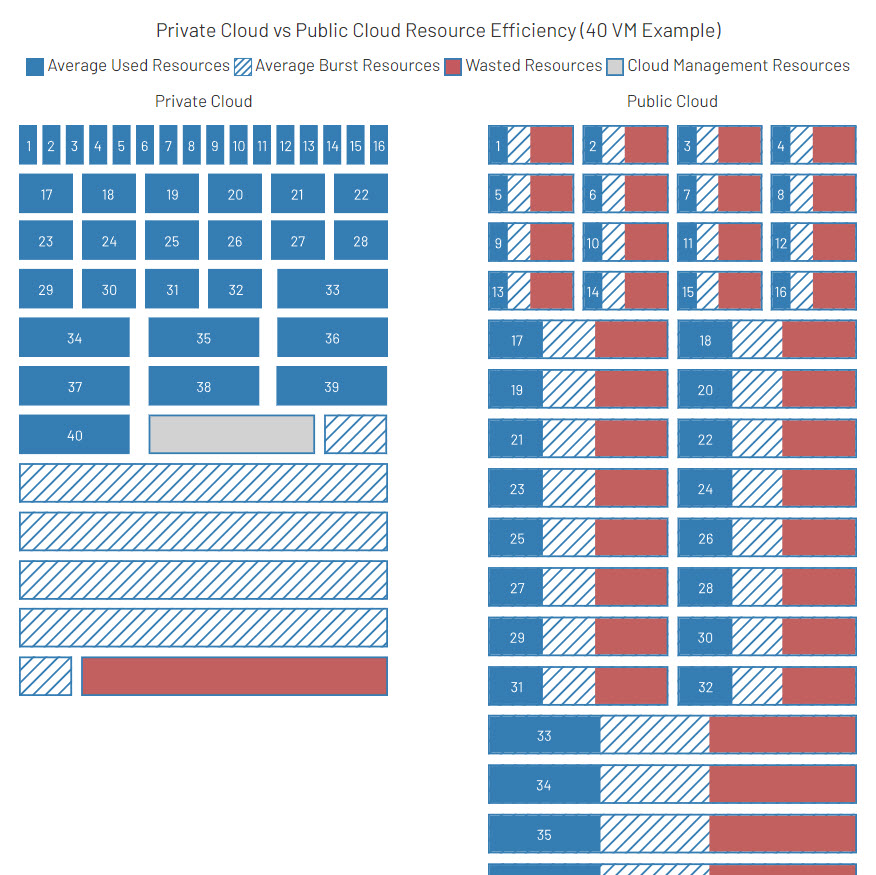
The illustrative ratios used below (30%, 30%, 40%) are based on very large data sets over many years pulled from our public cloud and private cloud customers and from inbound customers from mega clouds. These ratios are aggregates and specific workloads will have different characteristics.
More information about alternatives to public cloud is needed to help leaders in IT explain when public cloud is right or when private cloud, bare metal, colocation, or owned data centers are the right choice.
Private cloud vs public cloud resource efficiency – for the buyer!
Restated for clarity – when you lease a VM from a public cloud, you must pay for a VM for a workload that will use roughly 30% of the resources on average and will burst to use, when averaged out over time, no more than 30% more. When averaged, this leaves roughly 40% of the VM wasted.
Unfortunately, you must still lease this average wasted space by getting a much larger VM than your workload really needs. If you do not, your workload will run into limits periodically that will ultimately degrade your performance both at the rare, but critical times, your workload needs the full resources and at the times that the workload should already have finished but could not because it was delayed by resource constraints.
Occasionally you may hear the idea that if there is so much waste in the VM why not add more workloads into the VM. That is certainly one of the options, but it also negates the key benefit of workload separation that is fundamental to cloud and virtualization. And your system admin team or your SREs will be very angry with you! Usage of containers in VMs is a reasonably safe way to do this and is common already but typically for related parts of a single system which has its constraints. Either way, that requires quite a shift in thinking and typically design.
Please note that the above is for understanding the system difference – your individual workloads may run at a much lower average rate or at a much higher average rate. Math modeling or graphics rendering pipelines that are run continuously have a much higher average usage – think 70%. Web servers, database servers, and application servers typically are roughly 25%. Software development pipelines are examples of workloads that typically have lower average usage – as low as 10% as these typically do not run continuously.
Price reduction expectations for mega cloud providers
Companies in competition with Amazon and Google, but are also stuck paying for AWS and Google Cloud, will both cut costs and cut having to pay high rates to a competitor.
It is common for companies that are using hyperscalers to actually be in competition with that company in some facet of their business. For example, many retailers use AWS, the high margin side of Amazon’s business units. That high margin offsets the relatively low margin retail part of Amazon. As on-demand private cloud becomes more common, expectations are companies caught paying a competitor will quickly move to rectify that painful situation.
The transition of private clouds to being on-demand is transformational both for the companies that can now use the private clouds but also for large public clouds. As new feature parity services become available from the “second tier” providers around the world, the expectation is that pricing pressure on the mega clouds will drive costs down.
What about cloud repatriation costs?
Cloud repatriation is when a company is moving workloads out of the public clouds to be under the company’s direct responsibility. This is typically used to describe when moving from the “mega clouds” (AWS, Azure, GCP, etc.) and is done to reap the cost-savings benefits. What actually happens when a company moves the workload is more accurately called “workload repatriation” in most scenarios, and thus cloud repatriation is often a misnomer.
The advent of cloud repatriation as a term may have come from the idea that a company would be forced to not only move the workload but also move it “off the cloud”. The important distinction here is the “public cloud” is not the “cloud”. The cloud is a concept of separating hardware management from the usage of resources supplied by that hardware. In years past, it was complex to create your own cloud, but today many providers have released software or hardware and software combinations that make it trivial to create a cloud. (Our product, OpenMetal Private Cloud, accomplished the Trivial to Deploy moniker in 2020.)
Cloud repatriation does not require moving away from a cloud approach to infrastructure
Even if you have determined that your workload is a better fit for non-cloud approaches, it will often be the case that it is only the primary workload and not secondary supporting infrastructure. For example, you will still want object storage in your cloud for backups, but you might want direct hardware access for your databases without VM or container overhead. Modern clouds – by this I mean private clouds, public clouds, hybrid clouds, whatever you want to call them – can handle “bare metal” as well. So run your bare metal workloads on the bare metal inside your cloud-based infrastructure.
So maybe the origin of this term intended cloud repatriation to mean to move your cloud back under your control? That to me makes sense. Other usages simply confuse the term though, even by critically important findings like the following.
Key study uses the cloud repatriation term versus workload repatriation
This term was recently used in an article by Andreessen Horowitz – a16z – called “The Cost of Cloud, a Trillion Dollar Paradox“. In that article the analysts looked at how medium-sized+ companies can find themselves significantly overpaying for infrastructure. So much so that the overall market value of users of the mega clouds, particularly companies that have a large COGS from infrastructure, is now depressed by “trillions”.
That article has many key findings and will be looked back on in a few years as a catalyst article. To our leadership, it was a call-to-arms by Andreesen Horowitz for mid-tier providers, providers like OpenMetal, to look at the market and decide if we can provide cloud solutions at a significant discount from what the mega clouds are charging.
Key Advantages of Private Cloud Over Public Cloud
There are two areas where private cloud has a distinct advantage over public cloud:
Empowering users to leverage new technologies without additional cost or red-tape
First, as key technologies are included within a modern private cloud, for no additional cost, it empowers users to leverage new technologies on their timeline and without complex red-tape. If a development team wants to experiment with a Kubernetes-based software deployment, the models and system are already available to them within their current IT infrastructure.
Retaining valuable in-house IT teams and talent by leveraging self-managed on-demand private clouds
Second, many companies are facing the move from in house data centers or colocation to cloud. The current IT team has significant value and that value is often partially negated by the move to a public cloud. Moving to a self managed on-demand private cloud leverages that existing team. This gives a company the ultimate in cost savings while keeping talented people that contribute much more than just IT services.
The top self-managed offerings will offer onboarding services, ongoing training, and 3rd level support from the provider. They may also offer managed private cloud and starting with that level of service may be logical as well. Self-managed provides the ultimate cost savings and leverages the talented people you already have.
Traditional private cloud has its own challenges including wasted resources that can eliminate any benefits. But modern private cloud providers have matured along with the rest of the cloud market. Using an OpenMetal cloud as a hosted private cloud is just one example.
Basecamp and Hey CTO on why they are leaving the public cloud
Well respected technologist David Heinemeier Hansson, the creator of Ruby on Rails and Co-Owner and CTO of 37signals (Basecamp and HEY) weighed in on their choice to “decamp” from the public cloud. And yes, guess what, they were facing huge bills from the public cloud and the panacea of the cloud turned out to just be a “wonderful marketing coup“.
I highly recommend reading this as he has offered up a real world story from a company that has experience in both running on the public cloud and running their own infrastructure. I am not sure of the management system in their own infrastructure, but his message is very clear about exercising caution when it comes to the mega [public] clouds. They also published a follow-up “Our cloud spend in 2022 ” that takes you deeper into the numbers.
Evolving Market Landscape for Cloud Providers
OpenMetal’s leadership in open source on-demand private clouds
It’s 2023 and many companies are facing huge pressure to trim back their infrastructure spend and to increase the value they are getting from those dollars.
As this pressure builds, companies must truly evaluate their cost of infrastructure and educate themselves on alternatives to high cost mega cloud providers. This shift reminds me of the contentious position put out by Andreesen Horowitz that I’d mentioned above. They evaluated the damage done to their portfolio of investments from those portfolio companies’ usage of high cost public cloud. Their position was clearly counter to the public opinion at the time, but certainly now appears to be simply ahead of the game.
That takes us to today. Companies are deeply entrenched, and rightly so, into the concept of “cloud”. But, it is important to be crystal clear that cloud is not a destination. It is an approach that can be implemented in many ways and not just by moving to a few “mega public clouds”.
On-demand hosted private cloud removes startup expense and risk and gives you the benefits of the private cloud immediately. We are excited to bring this product to market and invite you to explore a new option to be “in the cloud”.
Why we chose private cloud resource management
As a cloud provider that merges public and private cloud benefits – i.e. private cloud at the speed of public cloud and with dynamic scaling – we often find ourselves answering often why we chose private cloud resource management versus a public cloud approach. There are many reasons, but one is private cloud’s core advantage for the VM tenant – our customer. It can be a bit tricky to explain so we fired up one of our designers and he created a few graphics, that hopefully, help answer the question.
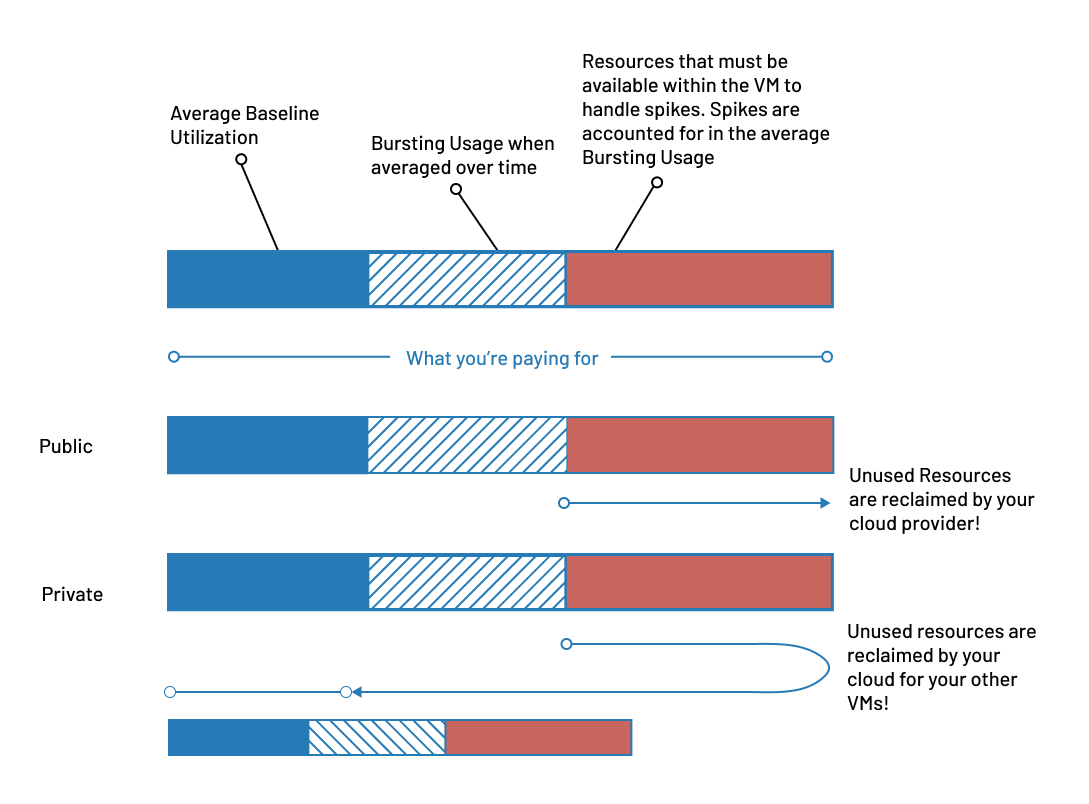
The advantage private cloud has over public in this area comes from a basic fundamental difference. You are leasing all the resources of the hardware and not just the virtual resources. This means when you provision a VM you can provision the size you need, but during the time that VM is not spiking to consume the top level limit of the VM, those previously wasted resources are accessible via your private cloud software to be used by your other VMs. In public cloud, your wasted resources are often designed to be reclaimed by the public cloud to be resold to other users!
The ongoing need for both traditional hardware providers and cloud providers (and your own experts)
When a company moves their workloads out of a public cloud it does not mean they move their workloads back to how those workloads were managed before. There is no reason to move to an older infrastructure model as having an in-house cloud is relatively straightforward nowadays. Did you use Terraform or Ansible to automate the creation of your cloud infrastructure on AWS, GCP, or Azure? Well, guess what, that same infrastructure as code mentality is supported by popular private cloud software like OpenMetal Clouds.
Did your dev team fall in love with Kubernetes? It is pretty awesome, for sure, and guess what, Kubernetes is also standard stock for any modern cloud.
Many companies have found that skills need to be reintroduced to the company to take on “cloud administration”. This may be a concern for you, but the ease of running clouds has also dramatically advanced in the past 5 years. For self-managed clouds, an experienced system administrator can learn to run clouds in as little as 40 hours. Relearning hardware is a valid concern, but one that has boundaries and multiple ways to de-risk including onboarding, service contracts, and management options that yield per VM costs that are still well below mega cloud costs and can be temporary.
Mastering Cloud Costs: Wrapping Up
The transition of private clouds to becoming on-demand has transformed the cloud infrastructure landscape, bringing affordability, flexibility, and ease of use to businesses of all sizes. As more companies look to reduce their reliance on public cloud providers, the growing market for on-demand private clouds and alternative clouds will continue to shape the future of cloud infrastructure and pave the way for further innovation and cost savings.
We believe that reducing reliance on the hyperscaler public cloud providers is both imperative and smart for businesses moving forward. Cloud costs have spiraled out of control and make growing your company nearly impossible once you’ve reached a certain point. Look into alternative cloud solutions like multi-cloud, hybrid, private, self-managed, and open source, and begin reaping the benefits.
More on the OpenMetal Blog…
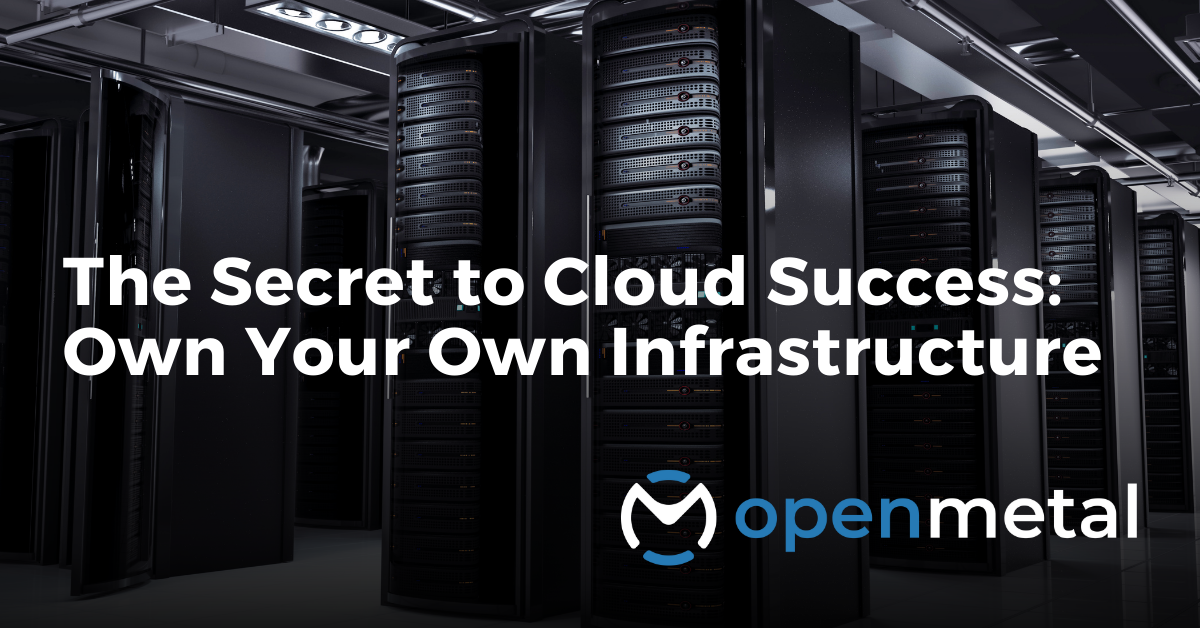
The Secret to Cloud Success: Own Your Own Infrastructure
In this blog:
- Searching for Cloud Success
- Features of Cloud Infrastructure
- Some Issues with Public Cloud Servers
- The Solution: Own Your Own Infrastructure
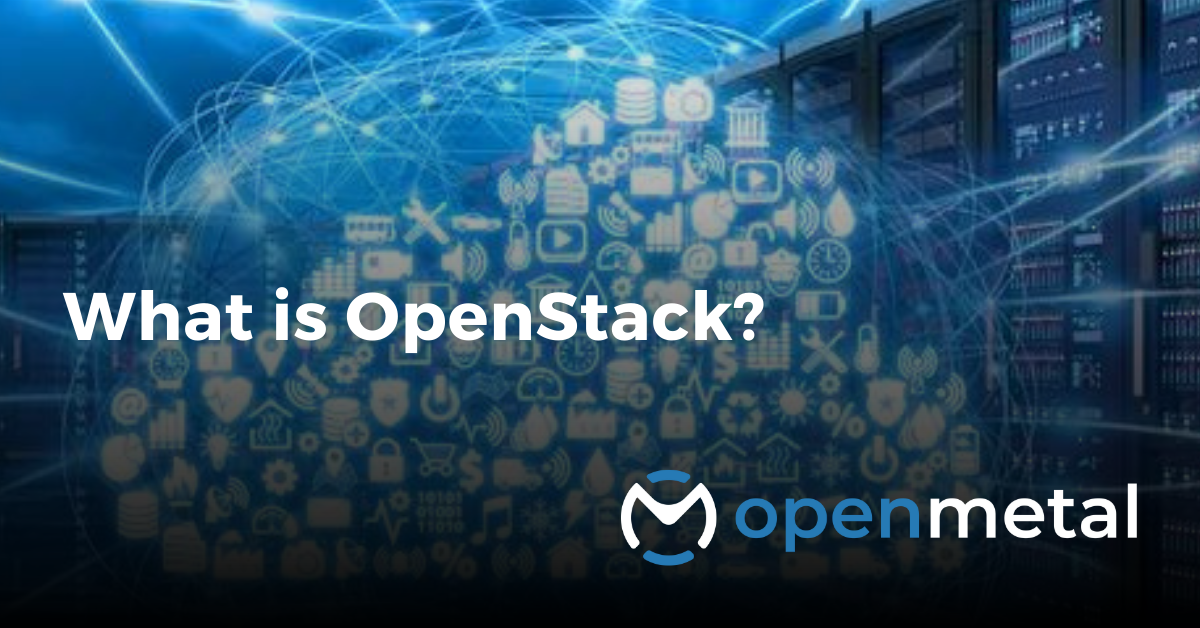
In this blog:
- What Is OpenStack?
- How Does OpenStack Work?
- Pros & Cons Of OpenStack
- Is OpenStack The Right Environment For Your Workloads?
- Get Started On OpenStack
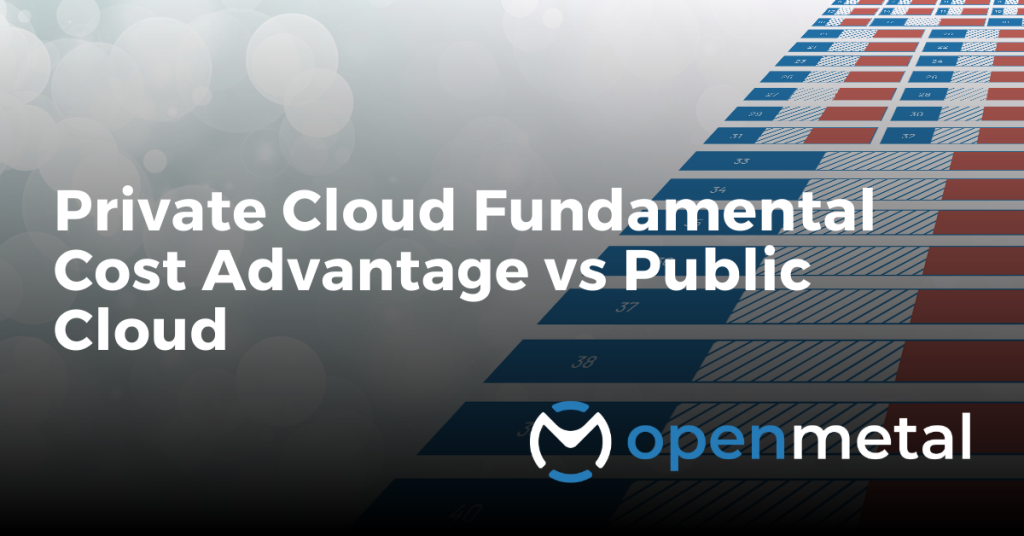
Private Cloud Fundamental Advantage vs Public Cloud
In this blog:
- Why does private cloud have such a significant advantage in cost and performance?
- Private Cloud vs Public Cloud Resource Efficiency for the Buyer!
Test Drive
For eligible organizations, individuals, and Open Source Partners, Private Cloud Cores are free to trial. Apply today to qualify.
Subscribe
Join our community! Subscribe to our newsletter to get the latest company news, product releases, updates from partners, and more.




































